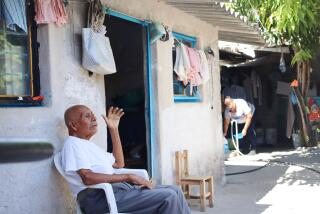Anti-pollution efforts clearing air in Tehran
The inhabitants of this metropolis of 12 million people, and perhaps as many cars, buses, trucks and motorbikes, have seen something new in recent months: the city itself, unobscured by the thick smog that normally blankets the capital.
For years, pollution in Tehran seemed to only grow worse, the stench of exhaust more dizzying, the number of patients rushed to hospitals with breathing difficulties ever increasing.
But a number of measures, including rationing gasoline and limiting traffic in the city center, have noticeably changed this bleak landscape and given back to Tehran residents the stunning vistas of the Alborz mountain range that surrounds the city.
“It feels much better than before,” said Marzieh Jannati, 27, shopping in south Tehran, an experience that used to burn the eyes of those unaccustomed to the pollution. “You can see the difference between these days and years past.”
Like Denver, mile-high Tehran’s thin air and curtain of mountains make it a natural harbor for air pollution. Industries on the outskirts and a glut of old vehicles add to lower air quality.
Officials began grappling with the air pollution problem in 1993, when they established the Air Quality Control Co. and began publishing daily pollution indexes, with color-coded billboards, in busy public squares.
A team of Japanese experts arrived to give officials three-day courses on how to detect ozone, lead and other poisons. The biggest problem, they were told, was unfiltered exhaust fumes.
Iranian authorities began requiring pollution-reducing catalytic converters on new cars. Long-delayed plans to build subway lines were launched.
But air quality continued to decline. The World Bank, which in 2003 lent Tehran $20 million to clean up the air, said the pollution in Iran’s major cities exceeded World Health Organization standards by 40% to 340%. Authorities regularly closed schools and asked frail residents to remain indoors on bad days.
The lowest point may have been Nov. 21, 2002, when all Tehran residents were asked to stay indoors because carbon monoxide concentrations had reached emergency levels, according to the World Bank appraisal.
An official Energy-Environment Review Policy Note estimated health damage from air pollution in Iran at over $7 billion in 2001, more than 8% of the nominal gross domestic product that year. A 2005 report by Tehran University found that rising carbon monoxide levels were contributing to heart failure, the leading cause of death in Iran.
But all agree there has been a turnaround in recent months.
A rationing program for heavily subsidized gasoline that began this summer sparked riots, but may have forced thrifty drivers to stay off the roads.
Strict controls and heavy fines placed on peak-hour traffic to central Tehran encouraged more commuters to use public transport, including a three-line subway system that has won praise for its efficiency.
Tehran introduced a fleet of natural gas-powered buses, ordered old taxis and buses to convert to natural gas engines, and banned decrepit cars.
In the last three years, about 250,000 Iranian cars have been converted to natural gas or hybrid engines, according to the Iranian Fuel Conservation Organization. Two years ago, production of the Peykan, a beloved but gas-guzzling and pollution-spewing sedan, was stopped.
Statistics from the Air Quality Control Co. show modest decreases in the levels of ozone, carbon monoxide, sulfur dioxide and nitrogen dioxide compared with two years ago, but much of the evidence so far is anecdotal.
The change can be seen in the skyline, which was often hidden in a brown haze, and in the lack of pedestrians wearing surgical masks in an attempt to filter out some of the poisons in the air.
“Until a few months ago, when I went home I felt something heavy was choking my lungs, though I used to wear the mask,” said Mehdi Papi, a traffic policeman. “Now, I don’t wear a mask and I feel much better.”
Mostaghim is a special correspondent and Daragahi is a Times staff writer.
More to Read
Start your day right
Sign up for Essential California for news, features and recommendations from the L.A. Times and beyond in your inbox six days a week.
You may occasionally receive promotional content from the Los Angeles Times.






